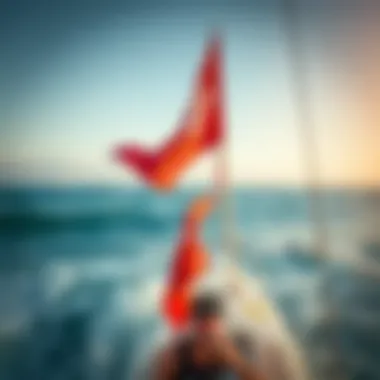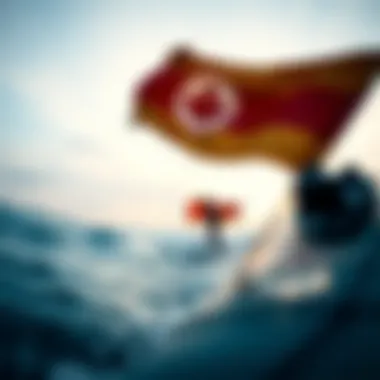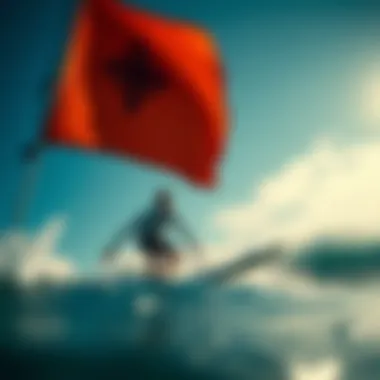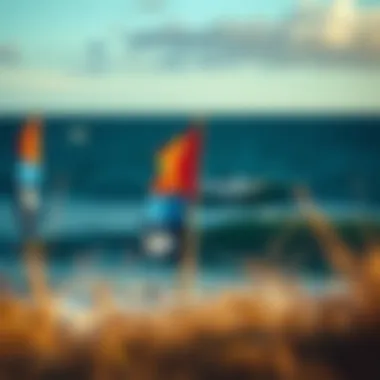Navigating the World of Surfing: Understanding Navigation Flags


Intro
The world of surfing is as thrilling as it is intricate. For those who ride the waves, understanding the cues that nature and fellow surfers provide is pivotal. Among these, navigation flags come into play, often fading into the background of discussions surrounding surfing safety and etiquette. This article seeks to shine a spotlight on these flags, exploring their different types and meanings, and how they contribute to a safer and more enjoyable surf experience.
Surfers often find themselves amidst changing tides, diverse beach conditions, and often unpredictable weather. A simple glance at a flag can inform them about potential hazards or accessible waves. By deciphering the signals these flags present, surfers can make educated decisions, fostering a safety-conscious environment for all. This guide will discuss various flag types you may encounter on beaches around the globe, as well as some local variations that are worth noting. We aim to empower new and experienced surfers alike with a clearer understanding of how navigation flags enhance both individual and collective safety, ultimately enriching the surfing experience.
Furthermore, this article will help bridge the gap between those who are just starting out and those seasoned in the sport, ensuring that everyone is attuned to the same safety measures. With insights into regional differences, readers will also gain an appreciation for how these flags have evolved over time. Let’s dive into the essential aspects of surfing navigation flags, their meanings, and their critical role in shaping the surf culture.
Understanding Navigation Flags
When it comes to surfing, there's more than just catching the perfect wave. The world of surfing encompasses a rich lexicon of navigation flags that play a significant role in enhancing safety and fostering communication among surfers. Understanding these flags isn't merely academic; it's essential for every surfer, whether you're just starting out or have been riding waves for decades.
Definition of Navigation Flags
Navigation flags are standardized symbols raised on beaches and at surf spots to convey crucial information to surfers and beachgoers. Each flag has a specific meaning, often indicating conditions related to safety, weather, and environmental factors. A bright red flag, for instance, typically warns surfers about dangerous waves or currents. In contrast, a green flag indicates that conditions are generally safe for surfing.
These flags serve as visual cues, ensuring that surfers can quickly and efficiently grasp the current conditions, which is vital for their safety. When flags flutter in the wind, they transform into silent sentinels, guiding surfers as they navigate the sometimes unpredictable ocean.
Importance of Navigation Flags in Surfing
The importance of navigation flags in surfing cannot be overstated. They are not just bits of cloth flapping in the breeze; they embody a vital part of surf etiquette and safety protocols. Here are some key points highlighting their significance:
- Safety First: Flags are indicators of water conditions, alerting surfers to potential dangers, such as rip currents or underwater hazards. Ignoring these warnings could lead to serious accidents.
- Communication Tool: In crowded surf spots, where verbal warnings may not carry over the noise of crashing waves, flags stand as a universal language.
- Environmental Awareness: Flags can also bear messages about marine conservation efforts, signaling the presence of protected species or advising on beach etiquette to preserve these delicate ecosystems.
- Standardization: Knowing what flags mean standardizes safety protocols across different locations. A surfer from California can decipher flag warnings just as easily while surfing in Hawaii.
As one might say, "It's better to be safe than sorry." Familiarizing oneself with navigation flags ensures surfers can enjoy their time on the water while minimizing risks. Taking heed of these flags fosters a safer and more enjoyable surfing atmosphere for everyone involved.
"Understanding navigation flags is like having a map in uncharted waters – it carves the way for safe adventures."
Types of Navigation Flags
Understanding the types of navigation flags becomes critical for surfers, lifeguards, and anyone engaging with oceanic conditions. These flags serve not just as colorful pieces of cloth blowing in the wind; they act as indicators of various safety conditions, surf rules, and environmental factors that can significantly affect one's experience in the water. The right flag can instantly communicate a plethora of information, creating a framework that fosters safety and informed decisions on the beach.
Surfers must familiarize themselves with these flags to navigate the surf safely. Whether you are a seasoned rider or just dipping your toes in, the importance of comprehending the flags can’t be overstated. These flags can mean the difference between a thrilling surf session and a dangerous encounter with hazardous conditions.
Standard Flags and Their Meanings
Diving into the specifics, let's break down some standard flags you are likely to encounter on the beach:
- Red Flag: This typically means no swimming is allowed due to dangerous conditions. If you see a red flag, take it seriously—strong currents or rough surf could be present.
- Yellow Flag: Moderate surf conditions are indicated by a yellow flag. While swimming is permitted, it’s wise to use caution—maybe stick to the shallows.
- Green Flag: A clear signal that the water is safe for swimming and surfing, a green flag invites you to hit the waves.
- Purple Flag: Look out for marine life hazards, particularly jellyfish. Seeing a purple flag means you should be cautious and vigilant in the water.
The presence of a flag does not just serve as a warning; it builds a community sense of responsibility. Every surfer should do their part to respect this signaling system.
Regional Variations in Flag Usage
While there are general standards to flag meanings, regional practices can differ dramatically. For instance, the flag protocols you might find on beaches in California may not line up with those in Australia or even Hawaii. This creates an intriguing challenge for surfers traveling to new locales.


In Hawaii, beaches could have additional flags related to ocean safety, like those warning of strong currents or riptides. Understanding the local system is paramount; some regions might even employ unique colors and signals that are unfamiliar to outsiders.
Taking the time to familiarize yourself with local flag protocols can offer valuable insights that enhance your surfing experience. Friends' suggestions or seeking advice from local lifeguards can prove invaluable, as indigenous knowledge often surpasses formal guidelines when it comes to coastal conditions.
Symbolism of Colors in Flags
The colors of flags themselves carry significant weight, each shade and hue invoking feelings and meanings that extend well beyond design. Understanding which colors symbolize safety and caution can influence not only your actions but also your attitude while in the water.
- Red signifies danger and alarm. It's a color that naturally prompts instinctive caution and alertness.
- Yellow speaks to moderation. This hue is easier on the eyes, representing a balanced approach to beach safety—everything from surf conditions to lifeguard presence.
- Green embodies calmness and permission, inviting surfers to enjoy the ocean without excessive concern. It’s an open invitation for recreational activities.
- Purple signals urgency. Often used in response to unpredicted threats, it warns surfers to be conscious of their surroundings, especially regarding the often-invisible dangers lurking in the water.
Recognizing this color language, surfers not only enhance their safety but also connect more deeply with the environment and culture surrounding the sport. There’s a story tied to every flag, anchored in its color and its relationship to the sea.
Armed with this knowledge about navigation flags, surfers can greatly improve their intuition regarding ocean safety and ensure their adventures are marked by excitement and security.
Flag Protocols for Surf Safety
When surfing, safety is a paramount concern that should never be brushed aside. The protocols outlined through the systematic use of navigation flags are essential tools in safeguarding surfers and beachgoers against unpredictable ocean conditions. Understanding these flag protocols not only enhances your safety but also ensures that everyone in the water is on the same page, creating a more harmonious environment.
Understanding Beach Warning Flags
Beach warning flags are the first line of defense for surfers contemplating a jaunt into the surf. Each flag carries specific meanings that inform beachgoers of the conditions present at that location. For instance, a red flag typically signifies dangerous water conditions, such as strong currents or high surf, advising surfers to be particularly cautious or to avoid the water altogether.
- Yellow Flag: Moderate surf or currents expected. Caution is advised.
- Green Flag: Conditions are generally safe for surfing. It’s go time!
- Black Flag: Prohibition on water activities. All surfers must stay ashore.
- Purple Flag: Presence of dangerous marine life, such as jellyfish or sharks, which warrants vigilance.
The clarity and consistency of these flags can mean the difference between an enjoyable surf session and a potentially perilous situation. Lifeguards often work in tandem with these flags, monitoring beach conditions closely and updating flags as necessary.
Flag Communication on the Water
In practice, flag communication amongst surfers while on the water is crucial. When a flag is raised, it’s a message sent from the beach to the ocean: a call to pay attention. Surfers should remain attentive to flags and be aware of their surroundings to interpret real-time conditions effectively.
- If you see a red flag from the lineup, it’s a signal to head back or stay close to the shore.
- Surfers should be proactive and share any updates on conditions with fellow surfers as well, especially if they notice changes that may not yet be reflected by the flags.
> Remember, communication is key in making water activities safer for all. Surfers have a responsibility to look out for one another.
Best Practices for Surfers
To enhance safety in the water using flag protocols, surfers should implement the following best practices:
- Stay Informed: Always check the beach flags before entering the water. Pay attention to local conditions, forecasts, and advisories.
- Buddy System: Surf with a partner. It’s always better to have someone keeping an eye on you.
- Plan Your Session: Choose your surfing times wisely, taking into account tidal movements and known hazards for your surfing spot.
- Know the Flags: Familiarize yourself with what each flag means. It’s crucial for your safety and others’.
- Alertness: Maintain awareness of the water around you, as things can change quickly. If you notice someone struggling or conditions worsening, communicate it.
Implementing these practices within the framework of navigation flag protocols increases overall safety for surfers and helps build a culture of awareness and mutual respect among beachgoers. As conditions change throughout the day, keeping these protocols in mind will not only ensure your own safety but also that of your fellow surfers. The ocean, while inviting, demands attention and respect in equal measure.
Navigation Flags and Environmental Awareness
Navigating the expansive ocean waves isn’t just about surfing; it’s also about understanding the environment we immerse ourselves in. The use of navigation flags serves a dual purpose: enhancing safety while simultaneously promoting a deeper awareness of the marine ecosystem. Recognizing and respecting the delicate balance of oceanic life can significantly influence our experiences on the water.
Flags Indicating Marine Life


In many surf spots around the globe, flags are used to indicate the presence of marine life. For instance, a flag featuring a simple fish icon may signify areas where dolphins or other playful marine creatures are known to frequent. In some regions, a specific flag might warn surfers about potential jellyfish sightings or the dangers posed by sea urchins. This kind of information is vital for surfers to stay alert and make informed decisions.
It’s imperative to note that these flags not only serve as warnings but also signify areas that could be particularly rich in biodiversity. Surfers who respect these flags can help preserve the habitat, fostering a relationship of coexistence with marine creatures.
"Being aware of our surroundings goes hand-in-hand with enjoying the surf; ignorance isn’t bliss when it comes to marine safety."
By paying heed to marine life flags, surfers contribute to reducing the risk of injuries and disturbances to wildlife. Each surf session becomes an opportunity to engage in eco-awareness, creating a culture of mindfulness in the surfing community.
Conservation Messages Communicated through Flags
Surfing spots often utilize flags as vehicles for conservation messages. These flags remind surfers of the pressing issues facing our oceans, including pollution, climate change, and overfishing. A flag displaying an image of a turtle, for instance, might represent a local initiative aimed at preserving turtle nesting sites or raising funds for ocean-cleanup projects.
Consider a brightly colored flag with a straightforward message: "Keep Our Ocean Clean." It not only serves as a reminder but also encourages surfers to partake in beach clean-ups and minimize their ecological footprint. This simple act of displaying a flag can create a ripple effect, inviting beach-goers to become stewards of their beloved coastlines.
Furthermore, active conservation rhetoric often extends beyond flags. Information on sustainable practices and marine preservation can be found on associated official websites linked with local surfing organizations, such as the Surfrider Foundation (surfrider.org) and the Ocean Conservancy (oceanconservancy.org).
Surfing is not merely a sport; it reflects a lifestyle that can be intertwined with environmental stewardship. Using navigation flags for educational purposes helps bolster a sense of responsibility among surfers, allowing them to not only navigate waves but also nurture and protect the ocean we rely on.
The importance of understanding navigation flags lies in recognizing their crucial role in promoting environmental awareness. As surfers traverse the waves, adhering to these guidelines plays an integral part in preserving the ecosystem that sustains our passion for surf.
Historical Evolution of Navigation Flags
The historical evolution of navigation flags is fundamentally entwined with the growth of surfing as a sport. Understanding this timeline not only enriches our knowledge of the flags themselves but also offers insights into how they evolved alongside surfing culture. Over the years, the symbols, colors, and protocols associated with these flags have transformed significantly, each change reflecting shifts in societal values, environmental awareness, and advancements in safety practices.
The origin of navigation flags dates back to when surfing was catching on as more than just a local pastime. As various communities began to adopt surfing, the need for a standardized way to communicate important safety information emerged. These flags became a visual language, a tool to convey vital messages about ocean conditions, local hazards, and various levels of danger. Their evolution marks a significant step in fostering a safer surfing environment, enabling surfers to make informed decisions based on real-time information.
Origins of Navigation Flags in Surf Culture
The earliest navigation flags within surf culture can be traced back to the mid-20th century, as surfing gained traction in places like California and Hawaii. Initially, flags were simple and lacked standardization, often reflecting local traditions or unique local fauna. For example, a simple red flag might indicate strong currents, while a colorful checkered flag signaled the presence of lifeguards on duty. The simplicity was a reflection of a burgeoning culture still finding its feet.
As surfing began to draw more people, particularly tourists, the necessity for a coherent signaling system became apparent. Local surf communities started to adopt more consistent flag systems, with some regions even generating their own interpretations and meanings. This regional variety, though beneficial for localized communication, sometimes led to confusion for visiting surfers unfamiliar with the local flag systems.
Changing Symbols through the Decades
Through the decades, the design and symbolism of navigation flags experienced evolutionary leaps. In the 1970s and 80s, as modern surf culture developed, so did a more structured approach to flag use. The rise of surf schools and lifeguarding programs brought with it an emphasis on education and safety. Consequently, flags began to adopt more standardized meanings across various beaches.
In this era, unique symbols emerged, like the yellow flag which indicated moderate hazard levels. Surfers learned the language of these flags, using quick glances to check the local conditions before paddling out.
In the recent past, with advancements in technology and communication, digital platforms have also started to play a part in how surfers interpret navigational signals. Even regional flags now find their meanings echoed in mobile apps, allowing for a more interconnected understanding of flag use, irrespective of one’s physical location.
The transformation of navigation flags from localized symbols to a more unified communication tool reflects not just changes in surfing, but also advancements in collective safety awareness across surf culture.
The present day sees flags not just as markers of danger or safety but as representatives of a wider ecological narrative, signaling events like beach clean-ups or conservation efforts. From the rudimentary designs of early surf culture to the sophisticated signaling systems of today, the evolution of navigation flags mirrors the growing awareness of surfers towards the environment and their commitment to ocean safety.
As we continue to explore the tides of surfing traditions, understanding the historical evolution of navigation flags provides clarity on their relevance today. They serve as a reminder of our past and guide us in maintaining safety and communication in the waves.


Practical Application of Navigation Flags
The practical application of navigation flags in surfing is crucial not just for safety but for enhancing the overall surfing experience. These flags serve as visual signals that communicate vital information about ocean conditions, beach safety, and potential dangers. Understanding how to utilize and interpret these flags effectively can make a world of difference in ensuring both personal safety and the safety of others in the water.
One of the significant benefits of navigation flags lies in their capacity to convey immediate information without extensive explanation. When surfers arrive at a beach, they can quickly assess the conditions by simply glancing at the color and position of the flags. For instance, a red flag typically indicates dangerous conditions, while a green flag signals that it’s safe to surf. This simplicity allows for swift decision-making in a sport where circumstances can change in the blink of an eye.
Moreover, knowing the flags fosters community awareness and encourages surfers to adhere to established guidelines. This collective understanding is essential for maintaining a safe environment on the beach. When everyone is on the same page regarding what the flags signify, it creates a sense of responsibility among surfers, leading to a more harmonious interaction with the ocean.
Case Studies of Flag Implementation
To illustrate the effectiveness of navigation flags, a few real-world case studies can provide insights into their implementation and impact on surf safety.
One notable example can be found along the beaches of Southern California, where a comprehensive flag system is in place. Beach authorities routinely update the flags based on weather conditions, rip current advisories, and marine life sightings. Lifeguards monitor ocean conditions intensely and change flags as necessary to keep surfers informed. Due to this proactive approach, incidents of rescues have noticeably decreased, reinforcing the importance of communication through flags.
Another vivid example can be observed in Maui, Hawaii, where the implementation of flags extends to environmental considerations. Not only do these flags warn surfers of strong currents or dangerous marine life, but they also signal preservation efforts. During sea turtle nesting season, specific flags indicate protected areas where surfers must refrain from entering. This initiative not only protects marine life but also promotes an overarching culture of environmental consciousness among beachgoers.
- The effectiveness from these examples illustrates that:
- Proper flag usage curtails risky behavior in the water.
- It also fosters respect for local wildlife and coastal ecosystems.
Testing the Effectiveness of Navigation Flags
To gauge how well navigation flags serve their intended purpose, various methods and tests can be utilized. Surveys and observational studies are some practical solutions employed by researchers and surf safety organizations.
For instance, in one study conducted at multiple beaches, researchers placed flags with different visibility levels. They observed whether surfers adhered to advice while under varying conditions, such as poor visibility or rough waters. The findings concluded that brightly colored flags significantly improve compliance rates compared to those that were less distinct.
Moreover, feedback from the surfing community plays an instrumental role in testing and refining these flag systems. Many surf schools have begun integrating discussions about flags into their curriculums, asking students to reflect on the significance and clarity of the signals. This approach not only educates new surfers but also empowers them to share their experiences with fishing and surfing communities, thereby enhancing understanding.
"In the surf, the only thing more essential than your board is awareness. Navigation flags are the unsung heroes of safe surfing."
As flag systems are continually assessed for effectiveness, future innovations may include understanding how flag-related communication could be improved with technology, such as apps or smart signage that integrate real-time updates. That way, surfers have the most accurate information at their fingertips, further enriching their connection with the ocean.
In summation, the practical applications of navigation flags encompass more than just physical markers on a beach. They represent a comprehensive system rooted in safety, community, and respect for the environment. Developing an acute awareness of flags is essential for anyone who finds joy in the waves.
Epilogue: The Role of Navigation Flags in Modern Surfing
The significance of navigation flags in surfing transcends mere communication; they serve as vital signals that enhance the surfing experience while ensuring safety on the water. In an environment where conditions can change in the blink of an eye, having a clear understanding of what each flag represents can be lifesaving. Surfing is not just about riding the waves, it's about being part of a larger ecosystem that includes other surfers, lifeguards, and marine life. Therefore, the role of navigation flags becomes integral in promoting not only individual safety but also community awareness and shared responsibility among surfers.
Summary of Key Points
- Essential Communication Tools: Navigation flags are the primary means of communication between lifeguards and surfers. Each flag conveys specific information regarding water conditions, hazards, and necessary precautions.
- Environmental Awareness: Many flags signal the presence of marine life or environmental hazards, fostering respect for the ocean's ecosystems. Understanding these signals can enrich surfers' connections to nature.
- Evolving Practices: The dynamic nature of surfing culture reflects the constant evolution of navigation flags. From traditional symbols to modern adaptions, surfers must stay informed about the changing meanings and new flags being introduced.
- Safety First: Navigation flags are implemented with the intent of safeguarding everyone involved. Familiarity with these flags can prevent accidents and injuries, thereby enhancing the overall surfing experience.
Future Trends and Innovations in Flag Use
Looking ahead, the future of navigation flags in surfing is poised for innovation, driven by technology and an increased focus on safety and environment. For example, digital flags, which can be updated in real-time and viewed via mobile applications, promise to revolutionize how surfers interact with flag signals. As the surf culture increasingly intersects with environmental consciousness, there may be a surge in utilizing flags to promote sustainability messages.
Furthermore, education initiatives targeting novice surfers will likely expand, ensuring that the next generation understands the critical role these flags play in maintaining safety and ecological awareness. Flag design may also see a creative twist, incorporating vibrant colors and more inclusive symbols to resonate with diverse surfer communities.
In summary, the future of navigation flags in modern surfing hinges on the intersection of safety, technology, and environmental stewardship. The commitment to enhancing surf experiences while respecting the ocean continues to grow, and so do the innovative uses of flags to support these efforts.
"Understanding navigation flags is not just about learning symbols; it's about connecting with the ocean and those who share it."
For more detailed information about surfing safety, you might refer to resources from organizations such as the Surfrider Foundation at https://www.surfrider.org or the International Surfing Association at https://www.isasurf.org.















